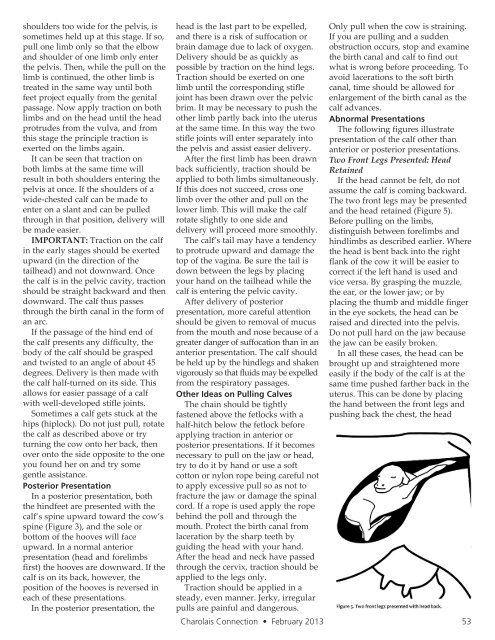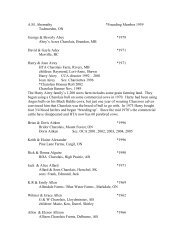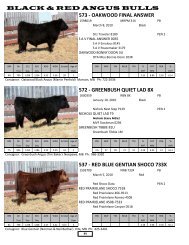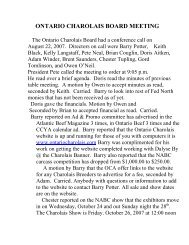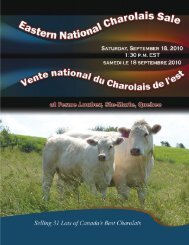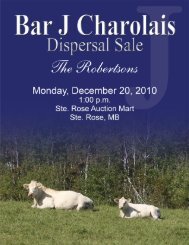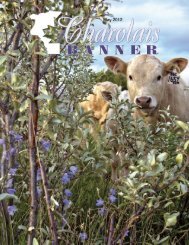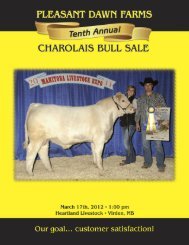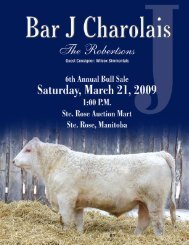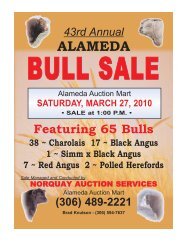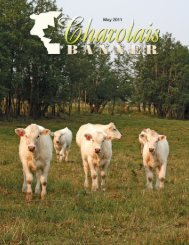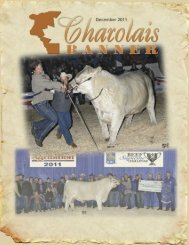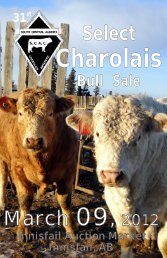Create successful ePaper yourself
Turn your PDF publications into a flip-book with our unique Google optimized e-Paper software.
shoulders too wide for the pelvis, is<br />
sometimes held up at this stage. If so,<br />
pull one limb only so that the elbow<br />
and shoulder of one limb only enter<br />
the pelvis. Then, while the pull on the<br />
limb is continued, the other limb is<br />
treated in the same way until both<br />
feet project equally from the genital<br />
passage. Now apply traction on both<br />
limbs and on the head until the head<br />
protrudes from the vulva, and from<br />
this stage the principle traction is<br />
exerted on the limbs again.<br />
It can be seen that traction on<br />
both limbs at the same time will<br />
result in both shoulders entering the<br />
pelvis at once. If the shoulders of a<br />
wide-chested calf can be made to<br />
enter on a slant and can be pulled<br />
through in that position, delivery will<br />
be made easier.<br />
IMPORTANT: Traction on the calf<br />
in the early stages should be exerted<br />
upward (in the direction of the<br />
tailhead) and not downward. Once<br />
the calf is in the pelvic cavity, traction<br />
should be straight backward and then<br />
downward. The calf thus passes<br />
through the birth canal in the form of<br />
an arc.<br />
If the passage of the hind end of<br />
the calf presents any difficulty, the<br />
body of the calf should be grasped<br />
and twisted to an angle of about 45<br />
degrees. Delivery is then made with<br />
the calf half-turned on its side. This<br />
allows for easier passage of a calf<br />
with well-developed stifle joints.<br />
Sometimes a calf gets stuck at the<br />
hips (hiplock). Do not just pull, rotate<br />
the calf as described above or try<br />
turning the cow onto her back, then<br />
over onto the side opposite to the one<br />
you found her on and try some<br />
gentle assistance.<br />
Posterior Presentation<br />
In a posterior presentation, both<br />
the hindfeet are presented with the<br />
calf’s spine upward toward the cow’s<br />
spine (Figure 3), and the sole or<br />
bottom of the hooves will face<br />
upward. In a normal anterior<br />
presentation (head and forelimbs<br />
first) the hooves are downward. If the<br />
calf is on its back, however, the<br />
position of the hooves is reversed in<br />
each of these presentations.<br />
In the posterior presentation, the<br />
head is the last part to be expelled,<br />
and there is a risk of suffocation or<br />
brain damage due to lack of oxygen.<br />
Delivery should be as quickly as<br />
possible by traction on the hind legs.<br />
Traction should be exerted on one<br />
limb until the corresponding stifle<br />
joint has been drawn over the pelvic<br />
brim. It may be necessary to push the<br />
other limb partly back into the uterus<br />
at the same time. In this way the two<br />
stifle joints will enter separately into<br />
the pelvis and assist easier delivery.<br />
After the first limb has been drawn<br />
back sufficiently, traction should be<br />
applied to both limbs simultaneously.<br />
If this does not succeed, cross one<br />
limb over the other and pull on the<br />
lower limb. This will make the calf<br />
rotate slightly to one side and<br />
delivery will proceed more smoothly.<br />
The calf’s tail may have a tendency<br />
to protrude upward and damage the<br />
top of the vagina. Be sure the tail is<br />
down between the legs by placing<br />
your hand on the tailhead while the<br />
calf is entering the pelvic cavity.<br />
After delivery of posterior<br />
presentation, more careful attention<br />
should be given to removal of mucus<br />
from the mouth and nose because of a<br />
greater danger of suffocation than in an<br />
anterior presentation. The calf should<br />
be held up by the hindlegs and shaken<br />
vigorously so that fluids may be expelled<br />
from the respiratory passages.<br />
Other Ideas on Pulling Calves<br />
The chain should be tightly<br />
fastened above the fetlocks with a<br />
half-hitch below the fetlock before<br />
applying traction in anterior or<br />
posterior presentations. If it becomes<br />
necessary to pull on the jaw or head,<br />
try to do it by hand or use a soft<br />
cotton or nylon rope being careful not<br />
to apply excessive pull so as not to<br />
fracture the jaw or damage the spinal<br />
cord. If a rope is used apply the rope<br />
behind the poll and through the<br />
mouth. Protect the birth canal from<br />
laceration by the sharp teeth by<br />
guiding the head with your hand.<br />
After the head and neck have passed<br />
through the cervix, traction should be<br />
applied to the legs only.<br />
Traction should be applied in a<br />
steady, even manner. Jerky, irregular<br />
pulls are painful and dangerous.<br />
Only pull when the cow is straining.<br />
If you are pulling and a sudden<br />
obstruction occurs, stop and examine<br />
the birth canal and calf to find out<br />
what is wrong before proceeding. To<br />
avoid lacerations to the soft birth<br />
canal, time should be allowed for<br />
enlargement of the birth canal as the<br />
calf advances.<br />
Abnormal Presentations<br />
The following figures illustrate<br />
presentation of the calf other than<br />
anterior or posterior presentations.<br />
Two Front Legs Presented: Head<br />
Retained<br />
If the head cannot be felt, do not<br />
assume the calf is coming backward.<br />
The two front legs may be presented<br />
and the head retained (Figure 5).<br />
Before pulling on the limbs,<br />
distinguish between forelimbs and<br />
hindlimbs as described earlier. Where<br />
the head is bent back into the right<br />
flank of the cow it will be easier to<br />
correct if the left hand is used and<br />
vice versa. By grasping the muzzle,<br />
the ear, or the lower jaw; or by<br />
placing the thumb and middle finger<br />
in the eye sockets, the head can be<br />
raised and directed into the pelvis.<br />
Do not pull hard on the jaw because<br />
the jaw can be easily broken.<br />
In all these cases, the head can be<br />
brought up and straightened more<br />
easily if the body of the calf is at the<br />
same time pushed farther back in the<br />
uterus. This can be done by placing<br />
the hand between the front legs and<br />
pushing back the chest, the head<br />
<strong>Charolais</strong> Connection • <strong>February</strong> <strong>2013</strong> 53


